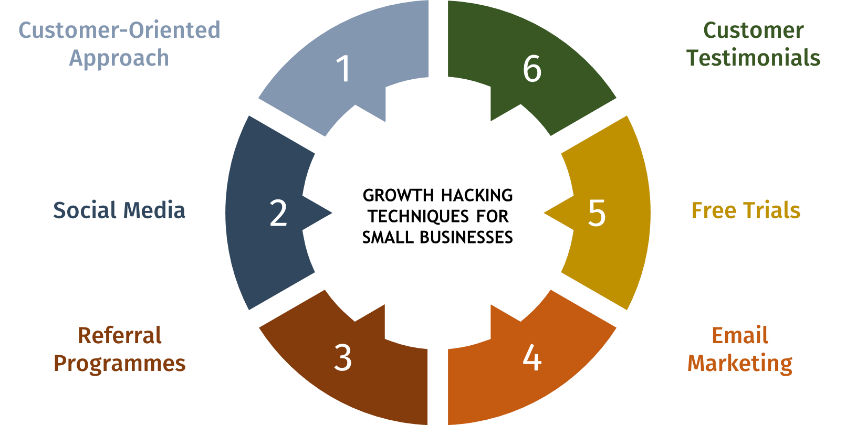Introduction
In today’s fiercely competitive business landscape, the race for success has intensified, making it particularly challenging for small enterprises to establish themselves and sustain growth. Growing in this cutthroat environment has become a formidable task. However, difficulty does not mean impossibility. With the right growth strategies, small businesses can not only survive but also thrive. Achieving this, however, hinges on embracing well-crafted techniques and cultivating a profound market understanding.
In contrast to conventional methods adopted by small businesses, growth hacking techniques emerge as a dynamic approach that prioritizes swift and optimal expansion. These strategies leverage inventive and cost-effective means to succeed. For small enterprises, growth hacking acts as a transformative tool to differentiate themselves and make a resounding impact. It serves as a channel, enabling them to swiftly onboard new customers and boost revenue without incurring significant financial outlays, unlike traditional approaches.
Let’s now delve deeper into some effective growth hacking techniques that can propel small businesses forward:


1) Customer-Oriented Approach
At the heart of successful growth hacking is a deep comprehension of customers’ needs and behaviour. This understanding transcends basic demographic information and delves into the nuanced aspects of customers’ motivations, needs, and actions. By grasping these valuable insights, businesses can customize their strategies to align with customer preferences, ultimately maximizing their growth potential.
Small businesses enjoy a distinct advantage in providing personalized customer experiences. This tailored approach enables direct interactions, meaningful conversations, and a more profound understanding of individual preferences. These interactions foster increased trust, elevated customer satisfaction, and an emotional bond between the business and its customer base.
2) Social media
Rather than spreading resources thinly across all available social media platforms, it is crucial to identify and focus on platforms that align closely with the target audience’s preferences. Understanding where potential customers predominantly spend their online time empowers the direction of efforts toward establishing a strong and captivating presence on those specific platforms. This approach not only optimizes the effectiveness of the marketing strategy but also increases the likelihood of resonating with the intended audience.
Creating a meaningful social media presence goes beyond simply sharing promotional content. Engaging with followers through actions like comments, likes, and direct messages cultivates a sense of community and responsiveness. Collaborating with influencers—individuals who possess a substantial following capable of endorsing the brand—holds significant potential. Such partnerships can tremendously amplify the brand’s reach and bolster its credibility.
3) Referral Programs
Referral marketing, often referred to as word-of-mouth marketing, offers a significant avenue for small businesses to achieve significant growth. This strategy centers on leveraging the existing customer base to spread positive recommendations of the business within their social networks, including friends, family, and acquaintances. This tactic capitalizes on the trust that people place in suggestions coming from individuals they know personally. Consequently, referral marketing stands out as a powerful driver for attracting new customers and expanding the reach of the brand.
By offering rewards to customers who effectively refer new clientele, businesses give them a tangible reason to actively advocate for the brand. These rewards can come in various forms, such as monetary incentives or exclusive offers. Setting up a structured program emphasizes the fairness and transparency of the process, including clear steps for making referrals, tracking progress, and distributing rewards. This organized approach increases the likelihood of successful referrals and cultivates a sense of excitement among existing customers, ultimately boosting the impact of referral marketing as a growth strategy.
4) Email Marketing
Integrating personalization assumes a crucial role in creating a connection with the audience. Carefully composed emails that use recipients’ names and deliver content tailored to their unique interests and behaviour stand out. By providing value through informative articles, exclusive promotions, and relevant updates, these emails surpass mere advertisements. This approach establishes a bedrock of trust and respect, motivating recipients to retain their subscription and view the emails as a valuable resource.
5) Free Trials
Offering free trials is a proven technique employed by businesses to attract new customers, showcase their product’s value, and ultimately drive long-term growth. Free trials allow potential customers to experience the product or service firsthand without committing to it financially. Free trials act as a low-risk entry point for customers, thus encouraging hesitant and curious prospects to take the first step towards the brand. Free trials also offer a chance to collect valuable feedback from users. This can provide insights, suggestions, and help identify potential issues. This feedback loop enables small businesses to refine and improve their product based on real user experiences, enhancing its overall product quality.
However, free trials should be carefully executed. The trial period should be long enough for users to understand and experience the product’s benefits but not so long that it leads to delayed decision-making.
6) Customer testimonials
Customer reviews can significantly contribute to the growth of small businesses. Positive reviews build trust and credibility, thereby influencing prospective customers to choose you over competitors. They also enhance your online reputation, making you stand out in a competitive market. Reviews act as digital word-of-mouth, reaching a wider audience and driving engagement. They impact purchase decisions, provide insights for improvement, and boost your online presence through SEO. By showcasing customer experiences, businesses can foster trust, attract new customers, and build a solid foundation for growth.
Conclusion
Growth hacking for small businesses involves thinking outside the box, being data-driven, and relentlessly pursuing growth opportunities. Embracing customer-centricity, exploiting the power of digital marketing, and fostering a culture of experimentation are some ways to unlock a business’s true potential. However, growth hacking is an ongoing process, and staying adaptable and open to change will be the key to success. With right growth hacking techniques, there is no denial to the fact that businesses can thrive and sustain.

